


♢ Symprites are the main species found on Capricorn-13! ♢
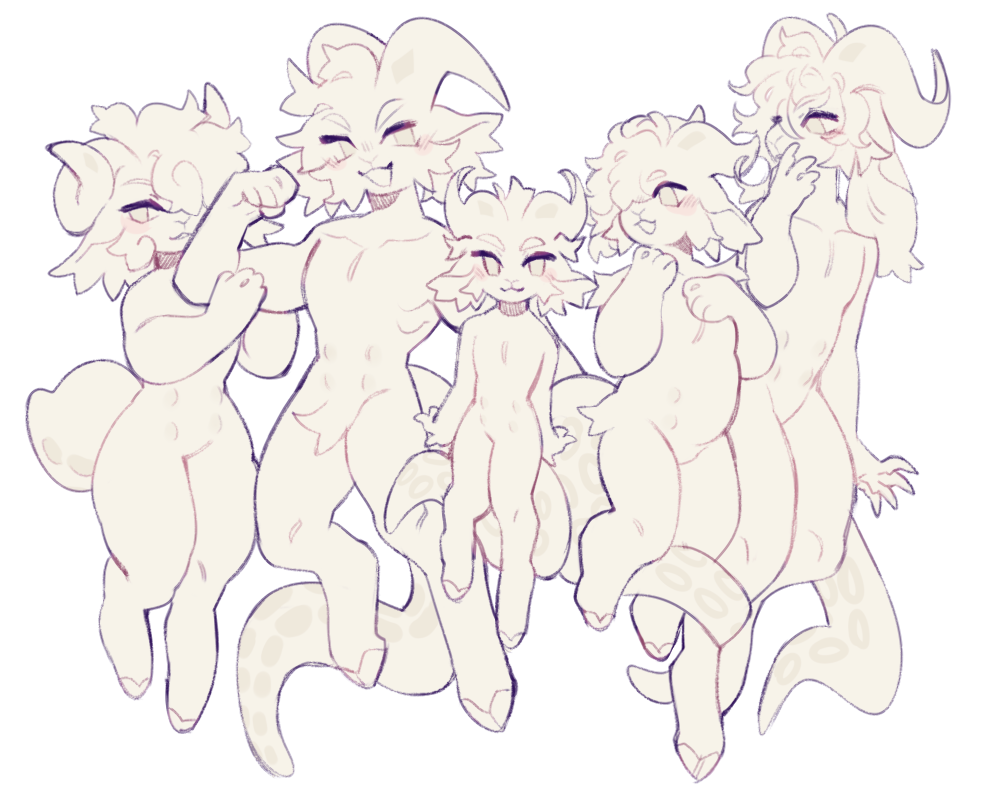

Symprites, also known as Symps, are bipedal goat-like creatures that live on planet Capricorn-13!
A Symprite is made out of 2 organisms: the goat creature which were terrestrial mammals before the Great Merge but now have the capabilities and genetic makeup comparable to an amphibious mammal, and their biote which works in harmony with the Symprite’s system, serving as a power plant in a way. The biote is a friendly parasite that merged centuries ago with the species, now living in a symbiotic relationship with its host.
Symprites have their signature goat-like muzzle with a long tongue, retractable claws and goat-like hooves. Their long tongues are a side effect from evolution after the bonding with the biote. They are prehensile and flexible, particularly useful for snacking on coral and shellfish which are staple foods in a Symprite's diet.
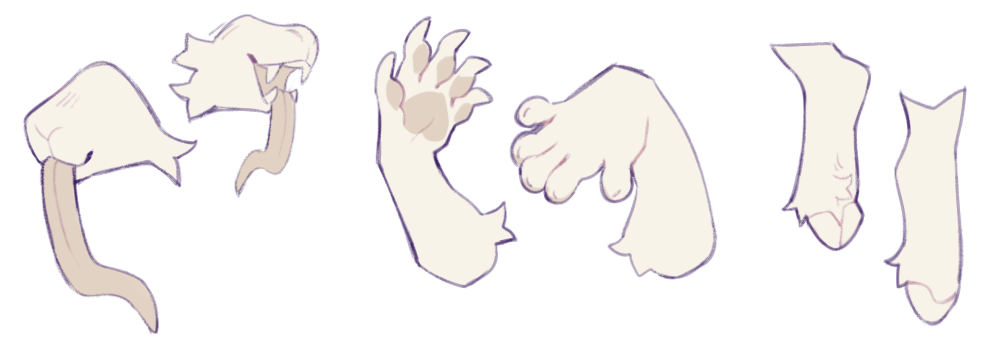
Symprites are known for the strong, sturdy musculature in their legs, being as they're constantly on their feet (or technically hooves) and always working those muscles!

Symprites are covered in a mix of fur and soft-plated scales. The fur protects them from the harsh outdoor environment, while the smooth and soft scales make them very versatile and fast underwater. Some subtypes also have thicker scales and fur covering areas of their bodies, as they have adapted to the climates of their biomes.
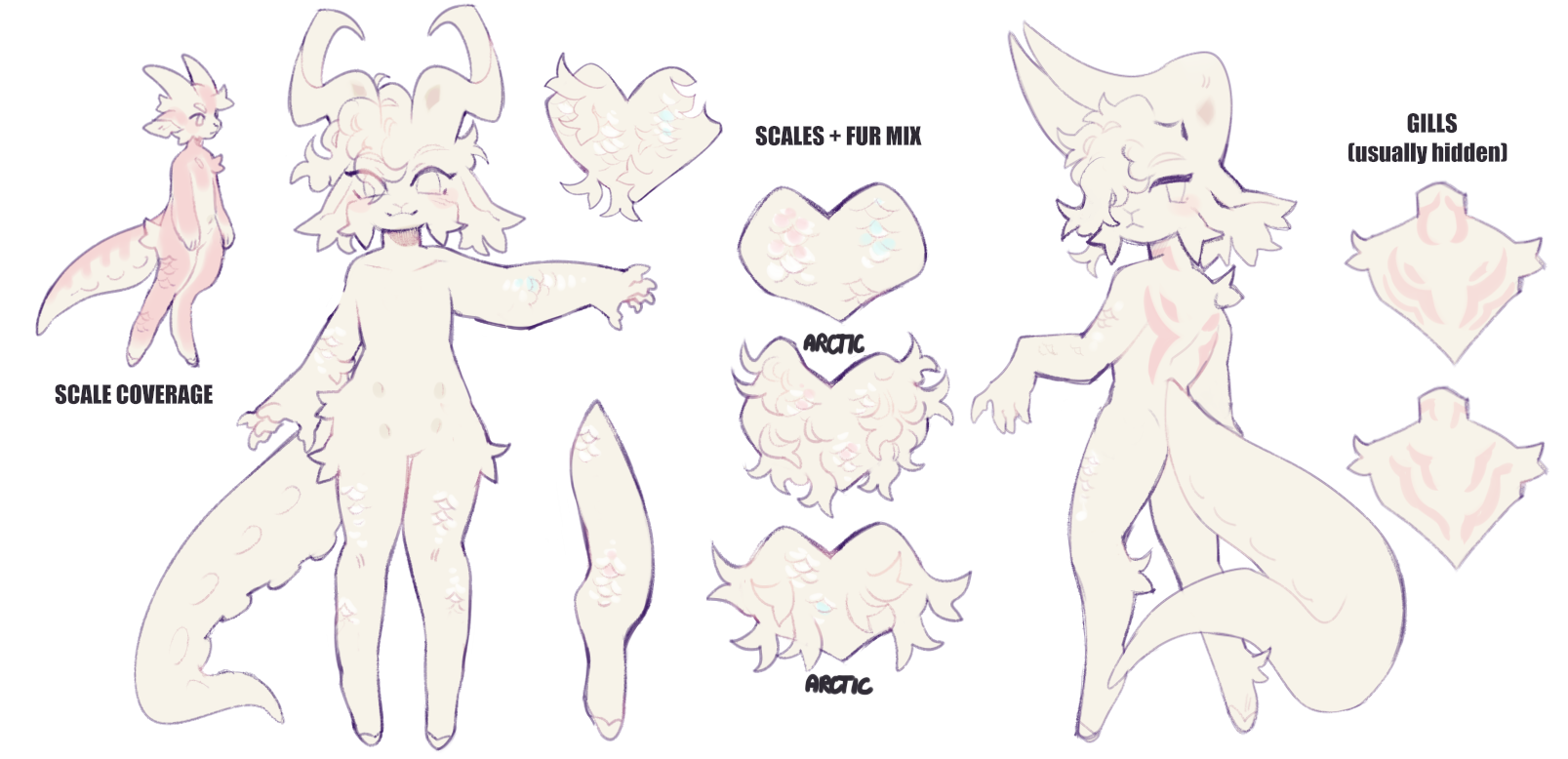
A Symprite's gills are only visible as faint lines (or sometimes not at all) most of the time.
They only open and appear more clearly when submerged in water!
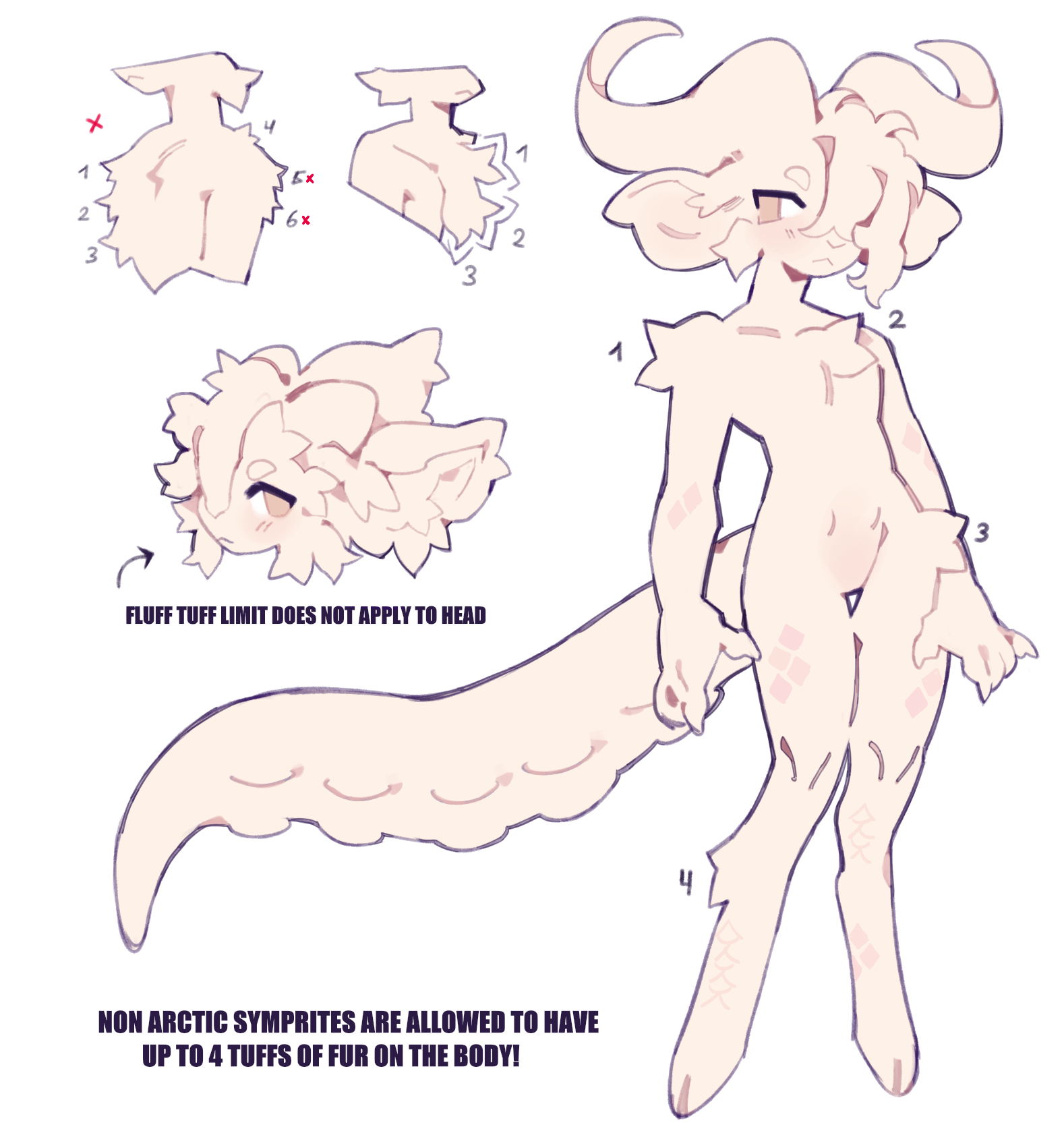
Symprites that are NOT Arctics are limited to 4 tufts of fur on the Masterlist!
Keep this in mind when submitting a Masterlist image. (Note: This does not apply to personal art, only the Masterlist image.)

Symprites at their core are hoard creatures and will often hoard a specific item that they like. This ranges from items they find from scavenging, all the way to delicate handcrafted items or gifts from friends and family.
They generally have a love of fashion and displays of creativity!
Smaller accessories, such as jewelry, are allowed on the Masterlist image, as long as it does not hide any traits or significant portions of the design; otherwise they can be drawn with a wide range of clothing and accessories.



Prehistoric Symprites were terrestrial mammals before the Great Merge but now have the capabilities and genetic makeup comparable to an amphibious mammal, able to breathe and navigate in the water, as well as on land. The symbiote works in harmony with the Symprite’s system, serving as a power plant in a way, by repurposing everything that they consume and converting it into energy that can be stored and used when needed. In this manner, they are unique in that they do not produce waste like other species. If they consume something that is unable to be converted by the symbiote, their body will reject it by vomiting. A Symprite’s horns are also a side effect from the symbiote, causing them to be hard and unbendable like a sword, but not unbreakable.
Most subspecies of Symprites have similar anatomy, with the exception of the Abyss, which have smaller lungs than the others due to the low oxygen levels in the lower ocean depths they frequent. The Abyss are also considered an oddity due to the fact that the form of their symbiotes typically resemble those akin to before the Great Merge, instead of the evolved symbiotes seen on the other subspecies. The Abyss symbiotes are the only ones to have seen a translucent mutation occur.


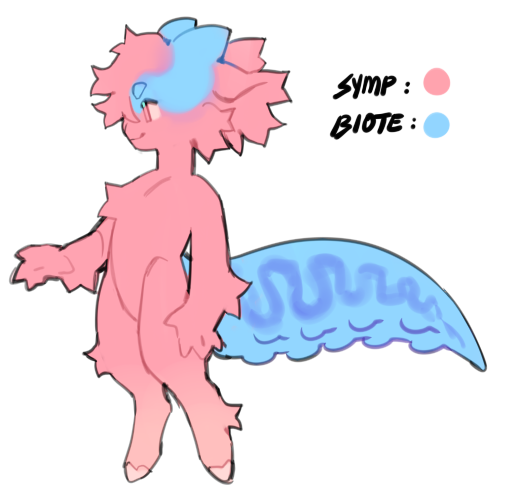
Symprites ordinarily have a pink-hued flesh tone that gradually transitions to match the colour of their symbiote as it gets closer to where the symbiote meets their natural skin, since that part of them is a parasitic entity connected to their body. While there are no limitations on the colour of a Symprite’s blood, the most common colour is red due to their heritage. Much like the flesh tone, the symbiote has its own blood colour, which is typically something like a dark blue or jet black.
The graphic to the left demonstrates where you would see the change in flesh and blood colour on a Symprite.
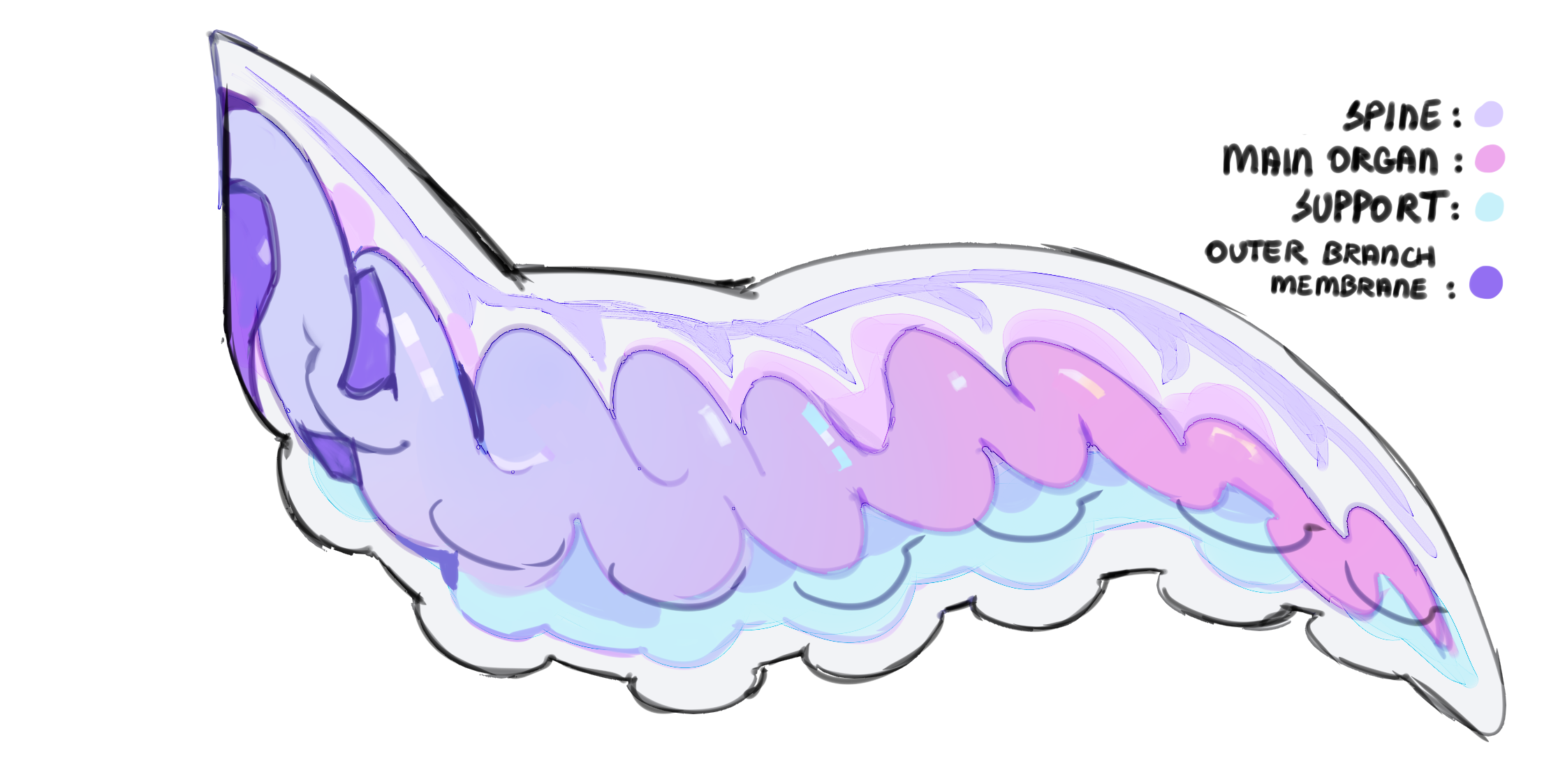


A Symprite’s general size depends on their subspecies, as shown in the size chart, but they can have a wide variety of body types, such as tall and slender or shorter legs with a wide torso. A Symprite’s environment may also influence their appearance as the symbiote provides a heightened adaptability in the species to ensure survival. For example, displacing an Ocean Symprite from a warm biome into a cold biome will cause additional fur to grow over time while also decreasing their need for sunlight and feeding frequency when compared to an Ocean Symprite living in its natural tropical habitat. Since there are very few regions of the world that experience seasons:
Traits, colours, and markings can lay dormant within bloodlines and appear in an offspring without either parent displaying it. This means that it is fairly common for a Symprite to be born with something like red eyes while the family all has blue eyes, so it is always an exciting and celebrated event when a bappy is born. Much more rare traits and mutations can also lay dormant for generations and may include, but are not limited to, multiple heads or extra limbs, horns, and eyes.


Symprites reproduce much in the same manner of the mammals of Earth, though a bappy is born from an egg laid by one of its parents. Bappies have assigned sexes at birth, but this does not matter when two Symprites decide to mate and produce offspring, as their anatomy is fluid in such a way that they can switch between sexes if preferred or needed. The symbiotic parasite reproduces asexually and is passed down through the egg during reproduction due to the unique relationship between Symprite and symbiote. While they are capable of producing offspring for many years, most Symprites prefer to bear between 1 - 4 offspring due to their generally carefree nature and to avoid overpopulation.

Symprites are known for their vibrant colours as bappies, which is a leftover defense mechanism in their genetic makeup from before the Great Merge to ward off predators, similar to that of poisonous frogs. These colours desaturate and fade as they get older. They reach maturity at around 20 - 22 years of age and while they originally had an average lifespan of 80 years, this has since lengthened to an average lifespan of 150 years! This is due to the symbiote slowing down the aging process when they reach about 30-40 years of age. Despite this long lifespan, it is rare to see Symprites reach old age due to the species being natural risk-takers and causing them to be more prone to cutting their life short. Eep!
There are exceptions to this general lifespan, such as the Tidepool and Abyss subspecies, who have an average lifespan of 400 years; though it is even more extremely rare to see an Abyss live into these high digits due to their nature and size.
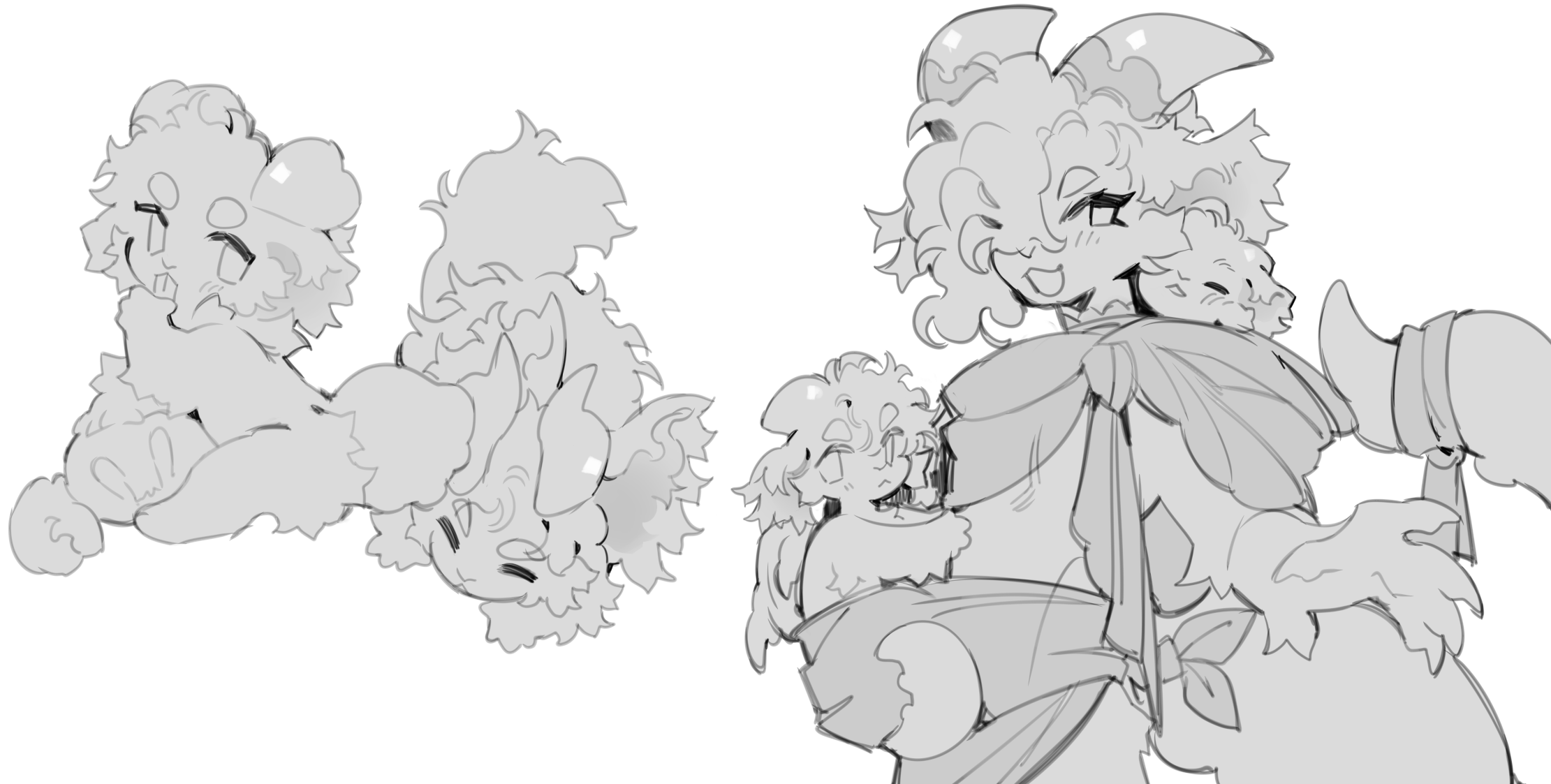


Symprites have an intelligence akin to humans, and they fulfill a similar role to humans on their own planet, being one of two known species with self-awareness and advanced societies - with Aramelles being the second! Every Symprite learns how to read and write in their own language while they are bappies, and they communicate through speech, writing, and body language. It is quite common to see small groups of younglings, typically around 4 - 8 bappies, following their Symprite teachers throughout the day in an informal educational system. Only a few Symprites have dedicated their lives to learn and master the ancient languages found in the abandoned ruins from past civilizations.
Once Symprites reach maturity (generally around the age of 20-22), they start to take on responsibilities within their communities, often turning their passions into professions. There are many roles and jobs for a Symprite to take on, from the most basic tasks of helping community members, farming, building houses and trading, all the way up to philosophers, scientists, archaeologists and leaders. Fishing and agriculture are the two main industries that make up Symprite communities, as they are omnivorous with a soft spot for fish (yum!) and fresh produce from a wide variety of crops. Hunters and gatherers are also highly valued for foraged goods and prized meats as favoured delicacies.
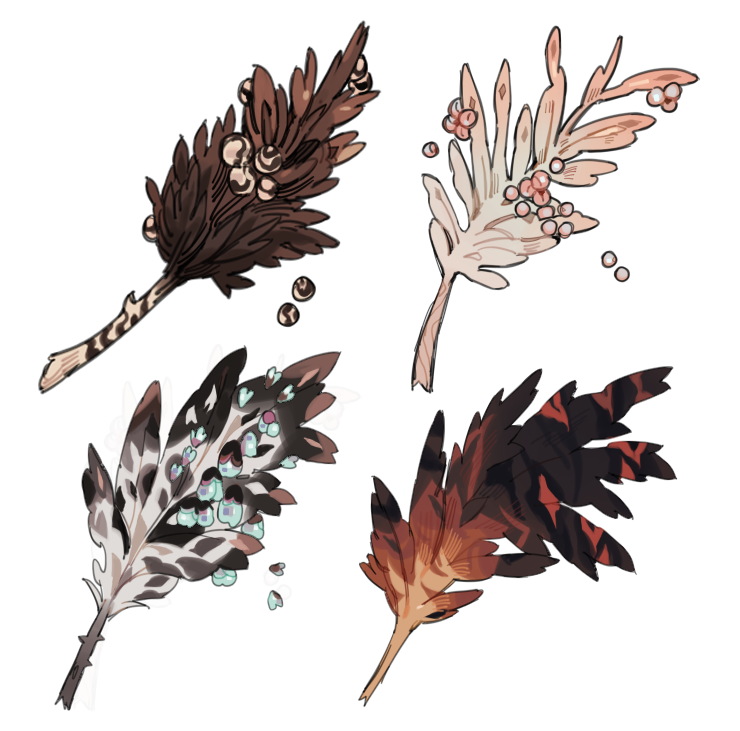

There is one important fishing village that every subspecies tries to travel to at least once yearly to gather supplies and news of the world. Large trading markets and festivals are a regular occurrence in this village, but there is one great trading event that takes place here once a year which attracts Symprites from all corners of the map for a few weeks. Scattered along the coasts and throughout the continent are many smaller villages and communities, as most of them settle down either in houses or caves. They are generally social beings with an inclination for lavish and ornate decorations, leaving a nomadic life most often undesirable.



It is all about community and teamwork for Symprites. They make friends easily, even among the subspecies, but are very easily intimidated by height which causes a larger social gap to overcome, the taller the other is compared to them. This issue quickly falls away with those they learn to trust, though every subspecies (except Tidepool) does have an unplaced unease around the Abyss ones even then. Symprites often prefer the company of others that are smart and caring compared to one who is selfish and a fool.
“Royal” bloodlines also exist, but not in the traditional hierarchical sense of the word. Royals, often identifiable by the spikes or ridges on their horns and their rowdy or robust appearance (most have a more dragon or bull build), do not in any way stand above others in society and in fact tend to be looked down upon if they slack off or pass off their responsibilities to others out of entitlement or laziness.

Symprites love to collect and add to their personal hoard, with many having specific favourites, such as peculiar shaped shells or polished pearls. Some eccentrics prefer to surround themselves with and hoard pieces of the old technology, which is rare, but can be found left behind from a prior civilization that no longer inhabits the planet. Symprites often use items from their collections for trading along with other commodities, food and supplies, as they do not have a uniform unit of currency. They are generous by nature and are happy to share from their hoard with loved ones or their community if needed, though they will always keep their most prized artifacts for themselves.

Often born with a creative eye, many Symprites have a passion for the arts in all forms. It is common to find a few artisans, composers and musicians within larger communities. Many centerpiece works of art are made with scavenged items from the old ruins or from treasures within their hoards. There is also a strong oral tradition within their society, so many great works of music and writing are passed down through the generations this way. You can often tell from where a Symprite comes from based on the oral histories they were taught as bappies.

